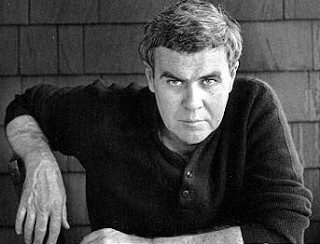Raymond Carver, a name synonymous with minimalist prose and poignant observations of everyday life, etched his place in literary history with his short stories. Among his most celebrated works, “What We Talk About When We Talk About Love,” stands out as a masterclass in dissecting the complexities of human relationships and the elusive nature of love itself. This story, part of his acclaimed collection, invites readers into a seemingly casual conversation that gradually unveils profound truths about love, marriage, and the human condition.
A Kitchen Table Symposium on Love
The narrative unfolds around a kitchen table, where two couples, Mel and Terri, and Nick (the narrator) and Laura, spend an evening drinking gin. In this intimate setting, a spontaneous discussion arises, turning to the weighty subject of love. Carver subtly echoes Plato’s Symposium, a classical text where philosophical ideas are explored amidst a drinking party. However, Carver transports this ancient concept to a distinctly 20th-century American landscape, focusing on the contemporary, often flawed, expressions of love between men and women. This modern symposium quickly deviates from idealized notions, plunging into the messier, more realistic terrains of love and relationships.
Dionysian Echoes: Love and Frenzy
The conversation takes a sharp turn when Terri recounts stories about her ex-boyfriend, Ed. She describes Ed’s possessive and violent “love,” recalling how he once dragged her around while proclaiming “I love you, I love you, you bitch.” This shocking anecdote introduces a darker, more turbulent understanding of love. Ed’s actions embody a Dionysian frenzy – a raw, untamed passion that veers into destruction. Mel further elaborates on Ed’s volatile nature, recounting threats and a suicide attempt, painting a picture of love intertwined with obsession and danger. These stories inject a chilling seriousness into the initially lighthearted gathering, forcing everyone to confront the potential for love to become destructive.
 Raymond Carver's "What We Talk About When We Talk About Love" book cover featuring a minimalist, evocative style.
Raymond Carver's "What We Talk About When We Talk About Love" book cover featuring a minimalist, evocative style.
Compassion Beyond Passion: Terri’s Love for Ed
Amidst the disturbing tales of Ed’s violent acts, a subtle nuance of love emerges through Terri’s actions. Despite Ed’s abuse, Terri reveals she sat by his side in the hospital as he was dying from a self-inflicted gunshot wound. This act of compassion, against Mel’s wishes, presents a different facet of love – one that transcends romantic passion or physical attraction. Terri’s compassion for Ed, in his most vulnerable state, offers a poignant counterpoint to the destructive “love” he exhibited. It suggests a capacity for empathy and care that persists even after immense pain and betrayal, hinting at a more profound, albeit complex, understanding of love.
The Honeymoon and Harsh Realities of Love
In contrast to Terri’s past trauma, Laura and Nick present themselves as the embodiment of “true love,” still in their honeymoon phase after nearly two years together. Their hand-kissing and knee-touching display a seemingly idyllic romance. However, Terri injects a dose of reality with a seemingly joking, yet pointed, “just wait.” This subtle jab underscores the story’s exploration of love’s temporal nature. Terri’s experience suggests that the passionate intensity of the honeymoon phase is not always sustainable, hinting at the inevitable challenges and transformations that relationships undergo over time. Her words foreshadow the potential disillusionment that can follow the initial euphoria of new love.
The Unsettling Questions: What Happens to Love?
Mel, reflecting on his own experiences, raises a deeply unsettling question: what happens to love? He admits to once loving his first wife intensely, only to now “hate her guts.” This stark shift in emotion prompts a broader inquiry into the durability of love. The story further complicates this question with Mel’s anecdote about an elderly couple severely injured in an accident. Despite their pain and incapacitation, the husband’s primary distress is his inability to see his wife. This poignant detail offers a contrasting image of love – one that endures hardship and focuses on connection and companionship even in dire circumstances. The story leaves the question of love’s permanence open, suggesting it’s a complex and evolving emotion, subject to time, experience, and individual perspectives.
Knights in Armor and Bees: Love and Destructive Impulses
As the gin flows, Mel’s desire for emotional invulnerability manifests in a peculiar analogy: he wishes to be like a medieval knight, shielded from pain. However, this desire for protection quickly morphs into a vengeful fantasy directed at his ex-wife, Marjorie. Fueled by anger and alcohol, Mel envisions unleashing bees upon her, knowing her allergy. This outburst echoes the Dionysian theme of uncontrolled passion and destructive urges previously seen in Ed. It reveals how even seemingly rational individuals like Mel can harbor dark impulses, particularly when triggered by emotional wounds and relationship conflicts. This episode highlights the volatile undercurrents that can exist beneath the surface of everyday conversations about love.
 Raymond Carver, a master of the short story genre, known for his concise and impactful writing.
Raymond Carver, a master of the short story genre, known for his concise and impactful writing.
Silence and the Human Heartbeat: The Story’s Enduring Power
The story concludes not with answers, but with a heavy silence. The characters, perhaps overwhelmed by the unsettling truths revealed in their conversation, fall quiet. Nick, the narrator, becomes acutely aware of the physical presence of each person: “I could hear my heart beating. I could hear everyone’s heart. I could hear the human noise we sat there making.” This ending emphasizes the unspoken anxieties and complexities inherent in human connection and the topic of love. The “human noise” – the collective sound of their beating hearts – symbolizes the raw, vulnerable reality beneath the surface of their words. Carver leaves the reader with a lingering sense of unease and a profound appreciation for the difficulty, and perhaps impossibility, of truly defining “what we talk about when we talk about love.” The story’s power lies in its unflinching portrayal of love in its messy, contradictory, and ultimately human forms, prompting readers to confront their own understandings and experiences of this universal yet deeply personal emotion.
